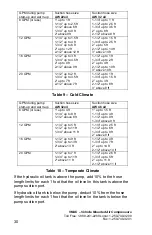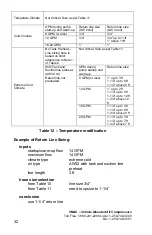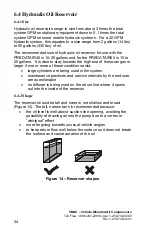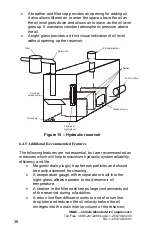
VMAC – Vehicle Mounted Air Compressors
Toll Free:
1-888-241-2289 Local: 1-250-740-3200
Fax: 1-250-740-3201
37
this is important on relatively small reservoirs (less than
about 1 gallon per GPM) where severe foaming and
aeration can occur if return line flow is not slowed prior to
tank entry.
•
A reservoir heater for preheating the hydraulic oil prior to
startup in extreme cold climate conditions.
6.4.6 Features Not Recommended
A suction screen or strainer is not recommended for mobile
equipment. The combination of long suction lines, cold startup
conditions and probable lack of strainer maintenance causes the
suction strainer to be more likely to promote pump damage (due to
cavitation) than it is to protect the pump.
A pressurized reservoir is not recommended for work trucks as it is
too sophisticated and provides too much potential for loss of overall
system reliability if it is not understood and not properly maintained.
6.5 Avoiding Cavitation
Pump cavitation may occur if the suction at the hydraulic pump inlet
exceeds 6 InHg (3psi) of vacuum relative to local atmospheric
pressure. Cavitation will severely reduce pump life & cause erratic
hydraulic system performance. Some steps to take to avoid pump
cavitation:
•
Mount the hydraulic oil tank as high above the pump as possible.
•
Keep the suction line as short as possible.
•
Avoid sharp 90 degree bends and sudden area changes in the
suction line wherever possible.
•
Keep all suction hose and fittings as large as possible.
•
If a suction line screen is used, be sure that it has sufficient high
flow rating.
•
If cold starting with the hydraulic oil at more than 2000 cSt (9200
SUS) viscosity, a no-load warm up interval should be used and a
pre-heater should be used on the tank and the suction line.
•
Wherever possible, use actual suction hose and thin walled barb
and clamp type fittings rather than high pressure hydraulic hose
and associated heavy walled fittings.
•
Make sure that the reservoir is of sufficient size


































